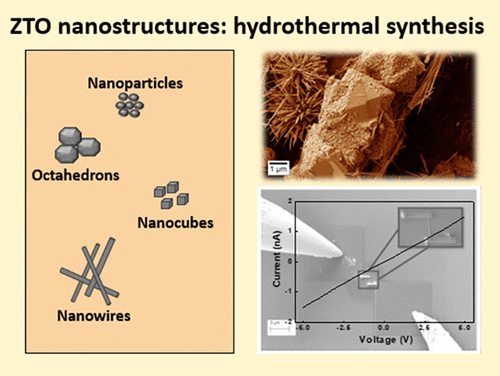
A. Rovisco et al., ACS Appl. Nano Mater., 1 (8), 3986–3997, 2018
Abstract
Semiconductor nanowires are mostly processed by complex, expensive, and high temperature methods. In this work, with the intent of developing zinc tin oxide nanowires (ZTO NWs) by low-cost and low-complexity processes, we show a detailed study on the influence of chemical parameters in the hydrothermal synthesis of ZTO nanostructures at temperatures of only 200 °C. Two different zinc precursors, the ratio between zinc and tin precursors, and the concentration of the surfactant agent and of the mineralizer were studied. The type and the crystallinity of the nanostructures were found to be highly dependent on the used precursors and on the concentration of each reagent. Conditions for obtaining different ZTO nanostructures were achieved, namely, Zn2SnO4 nanoparticles and ZnSnO3 nanowires with length ∼600 nm, with the latter being reported for the first time ever by hydrothermal methods without the use of seed layers. Optical and electrical properties were analyzed, obtaining band gaps of 3.60 and 3.46 eV for ZnSnO3 and Zn2SnO4, respectively, and a resistivity of 1.42 kΩ·cm for single ZnSnO3nanowires, measured using nanomanipulators after localized deposition of Pt electrodes by e-beam assisted gas decomposition. The low-temperature hydrothermal methods explored here proved to be a low-cost, reproducible, and highly flexible route to obtain multicomponent oxide nanostructures, particularly ZTO NWs. The diversity of the synthesized ZTO structures has potential application in next-generation nanoscale devices such as field effect nanotransistors, nanogenerators, resistive switching memories, gas sensors, and photocatalysis.